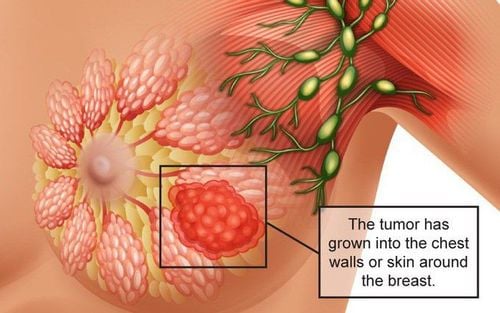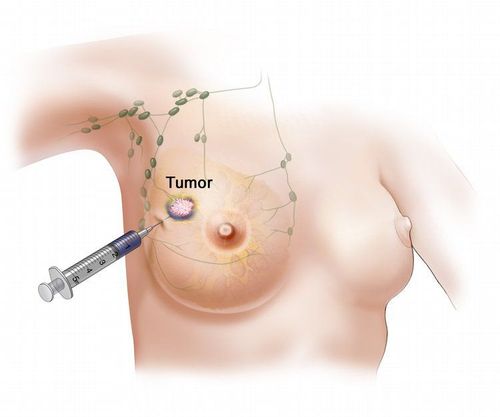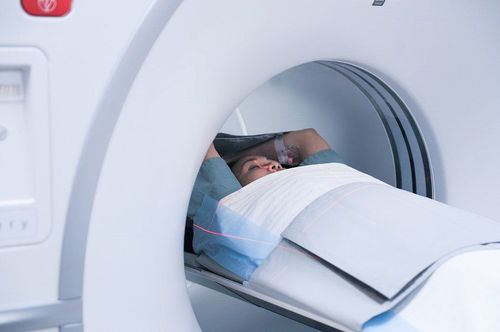This is an automatically translated article.
Lymphoma is a rare tumor in the breast, accounting for only 1% of all breast tumors. The disease is usually slow to progress and may include benign, malignant, and borderline benign forms that all require treatment.
1. What is mammary phylum?
Lymphoma of the mammary gland is a pathological form of the mammary gland. The disease usually progresses slowly, most of them are benign despite their large size. Most commonly seen in women aged 40-45 years. Men with gynecomastia can also get this disease. But in general, this is a rare disease.
Benign and malignant chlorophyll tumors are similar in appearance, well-defined, although the tumor has no true capsule; The size of the tumor varies quite a lot, from 1 to 40 cm, in the form of a round or oval mass, with a multi-arch border.
Tumor has a leaf-like structure, consisting of connective tissue and epithelium. Inside the tumor, there are cystic areas, areas of yellow fat, areas of hemorrhage, areas of necrosis, mucous and bulging sections, areas of strong fibers interspersed with soft tissues.

U diệp thể tuyến vú là một dạng bệnh lý lành tính của tuyến vú
2. Diagnosis of breast phyllodes tumor
2.1. Clinically In most cases, the diagnosis of tumor is not too difficult. However, cases of small tumors can be difficult to distinguish from fibroadenomas because they share the same histopathological origin of fibrous and mammary tissue. However, phyllodes tumor has some characteristics:
Lymphoma is usually detected by manual palpation, ultrasound, and mammography. About 20% of phyllodes tumor cannot be palpated by hand, so screening by mammography or ultrasound can detect Tumor large to giant, ultrasound shows cystic area. When a phyllodes tumor is suspected, a partial tumor biopsy or complete resection of the tumor is required for histopathological diagnosis. Usually painless, round and smooth. Tumors are usually well-defined, firm, and well mobile even though they are large, multi-lobed, and painless. Tumors usually grow slowly or quickly or a combination of slow and fast stages. For fast-growing tumors, it is often palpable and changes the shape of the mammary gland. The average size of the hump is about 4 - 7 cm. However, there are the smallest tumors only 1 cm, the largest can be up to 40 cm. In about 20% of cases, axillary lymph nodes can be palpable, but mostly benign reactive nodes, rarely with metastases. The skin over the tumor may be shiny, thin, with varicose veins above it. The nipple is rarely invasive, rarely pulled in; 2.2. Subclinical Mammography: Similar to fibroadenoma, it is a high-density, regular, multi-arched lesion without calcification. There were no signs suggesting benign or malignant phyllodes tumor. Ultrasound: The echo is homogeneous, in addition, it shows small peripheral cysts containing fluid. On ultrasound, it is also difficult to distinguish mammary syphilis from fibrocystic tumor, in addition to some suggestions such as cysts in the tumor, vascular proliferation. Fine Needle Aspiration (FNA): There is no standard to distinguish mammary phyllodes tumor from fibroadenoma. FNA should only be used to rule out melanoma and carcinoma. Cryosurgery: Distinguishing between phyllodes tumor and fibroadenoma on cryosection is difficult. The sarcoma-like component of a phyllodes tumor may be misdiagnosed as a poorly differentiated carcinoma, thus leading to unnecessary radical surgery; Biopsy: The removal of the entire lesion with or without normal breast tissue around the tumor. For the most accurate diagnosis.

Sinh thiết là lấy trọn sang thương kèm hay không kèm mô vú bình thường quanh bướu
3. Treatment of breast phyllodes tumor
3.1. First-time treatment Heal phyllodes tumor: Treatment is extensive resection. If the tumor was previously removed, re-expansion surgery or close monitoring can be performed.
Malignant chlorophyll tumor
Conservative treatment and mastectomy can be selected. However, with conservative treatment, the local recurrence rate is higher. One study showed that adjuvant radiation therapy after surgery can help reduce the local recurrence rate. The role of adjuvant chemotherapy in the treatment of malignant chlorophyll is also unknown. Axillary lymph nodes may appear in 10% - 20% of cases, mainly inflammatory lymph nodes, lymph node metastases in malignant chlorophyll tumors are less than 5%, so there is no indication for lymph node dissection. If lymph nodes are clinically suspected, biopsy the lymph nodes. 3.2. Treatment of local recurrence The majority of local recurrences are histologically similar to the original tumor. There is also a small percentage of tumors that transform from benign to malignant; For minor local recurrences, the patient can be resected with a margin of 2 - 3 cm. In case of large recurrence or recurrence of malignant chlorophyll tumor, the preferred method is mastectomy. 3.3. Treatment of distant metastases Less than 5% of cases of chlorophyll tumors lead to distant metastases, this rate for malignant chlorophyll tumors is about 10 - 25%;
Only the stromal component leads to distant metastasis. Tumor size, mitotic grade, and poorly differentiated stroma are important predictors of metastasis.
The most common distant metastases are lung, pleura, and bone. However, the results of treatment of distant metastases are very poor.
Treatment of distant metastases of phyllodes tumor is similar to that of connective tissue cancer. For resectable distant metastases such as isolated lung metastases, the preferred treatment is surgery.
Chemotherapy usually uses Ifosfamide, doxorubicin.
4. Some things to keep in mind
Local recurrence is a common complication of chlorophyll tumors, both benign and malignant. Therefore, patients after treatment need to visit the doctor periodically under the guidance of the doctor. Women should do a monthly breast self-exam as soon as their period is 5 to 7 days after their period stops, and have regular screening mammograms. For women who feel breast lumps on their own, it is necessary to visit a hospital with a specialist in mammography as soon as possible to check their status, to prevent the possibility that malignant tumors will be dangerous to health. Vinmec's breast cancer screening and early detection package helps to detect breast cancer early even when there are no symptoms.
When registering for the Breast Cancer Screening Package, customers will receive:
Examination and consultation with an oncologist. Breast cancer screening by bilateral breast ultrasound and mammogram.
Please dial HOTLINE for more information or register for an appointment HERE. Download MyVinmec app to make appointments faster and to manage your bookings easily.













